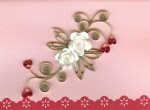 I’ve toyed with the idea of trying some other techniques with my quilled cards. The first technique I tried was paper pricking (piercing). That’s when you prick out a design on the card with a pin (or a special pricking tool). The design can be pierced from the front or the back of the card or a combination of both. It’s really quite pretty and combines well with quilling especially if you use the pierced design as a border. I felt it was way too time consuming to use on a card; I used the technique to make some very pretty background piercing on handmade paper (which I bought, I did not make it). Then I quilled bouquets of flowers which I put on the background and framed. I have since discovered (well I didn’t really discover it, but I found out about it) a tool called the pounce wheel. This wonderful little gizmo will do a pricked border in a jiffy! You can’t use it for everything, although I did do a very nice scalloped border, but I use it to give a pricked edge on some of the papers I use for my cards.
I’ve toyed with the idea of trying some other techniques with my quilled cards. The first technique I tried was paper pricking (piercing). That’s when you prick out a design on the card with a pin (or a special pricking tool). The design can be pierced from the front or the back of the card or a combination of both. It’s really quite pretty and combines well with quilling especially if you use the pierced design as a border. I felt it was way too time consuming to use on a card; I used the technique to make some very pretty background piercing on handmade paper (which I bought, I did not make it). Then I quilled bouquets of flowers which I put on the background and framed. I have since discovered (well I didn’t really discover it, but I found out about it) a tool called the pounce wheel. This wonderful little gizmo will do a pricked border in a jiffy! You can’t use it for everything, although I did do a very nice scalloped border, but I use it to give a pricked edge on some of the papers I use for my cards.I also bought a book on parchment craft . . . and parchment . . . and tools. However after sitting down and looking at the book, I decided I was not ready for parchment. It seemed very involved and rather complicated. What I have found though, is a book called The All New Compendium of Cardmaking Techniques by Search Press. It came up when I was doing a search for new quilling books. It has a 27 page section on quilling; the designs are some of the ones found in Diane Crane’s Quilled Greeting Cards. What it does have is very basic information for a number of other techniques. “Thread Cards” their term for paper embroidery is just one of them. While I might not want to make a whole thread card, that might be an interesting technique to use for the vase of quilled flowers. I always have to think about what design to use for a vase; making a “threaded vase” might give a whole different look and texture to a piece. It would be pretty small if I were making it for a card but might look pretty neat in a framed piece as well. Hmm . . . There is a section on watercolor cards, which I almost skipped right over . . . I don’t enjoy painting anything, furniture, walls, NOTHING! But . . . there is an interesting section on creating a wash for a background and getting some really neat looks using spattering and salt, of all things! The “Quick Parchment Cards” section has made me rethink the whole parchment thing, especially when I saw some of the border designs and saw it used on color cards. When I got to the silk flower section, I just substituted quilled flowers in my mind. The section on bead
 ed cards combined paper pricking and lace. I am not trying to read the whole book to you but it does have some good basic information so if you are interested in trying any of these techniques, I think it is a pretty good starting point. I have a whole bunch of small quilled pieces that I had made for the 2009 Accord calendar and of course that project got scrapped. So I think I will take a look at them again and look through my books and maybe I can really dress them up. I don’t usually send cards out for Halloween, but some of the designs are really cute Halloween designs, so maybe I will just surprise my family with Halloween cards this year.
ed cards combined paper pricking and lace. I am not trying to read the whole book to you but it does have some good basic information so if you are interested in trying any of these techniques, I think it is a pretty good starting point. I have a whole bunch of small quilled pieces that I had made for the 2009 Accord calendar and of course that project got scrapped. So I think I will take a look at them again and look through my books and maybe I can really dress them up. I don’t usually send cards out for Halloween, but some of the designs are really cute Halloween designs, so maybe I will just surprise my family with Halloween cards this year.



